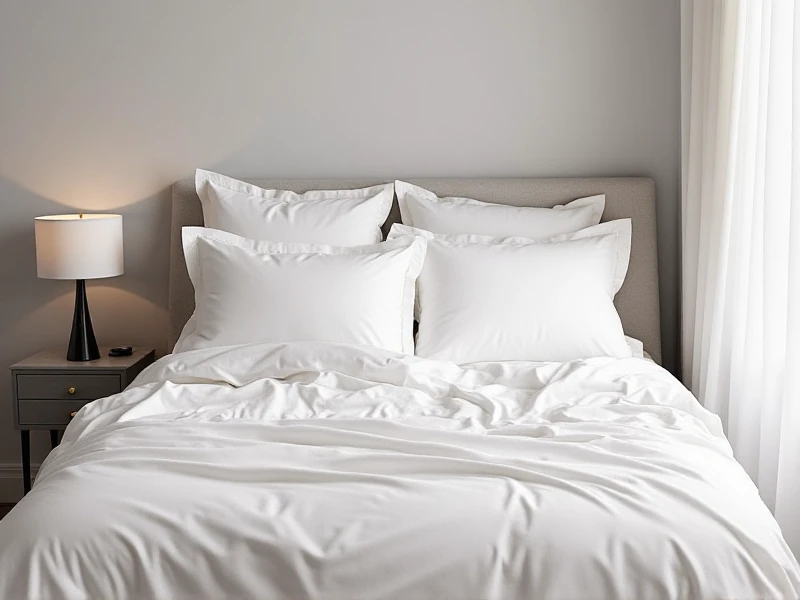The Ultimate Guide to Sheets: Choosing, Caring For, and Transforming Your Sleep
2025-06-10

Sheets are the foundation of a comfortable, inviting bed. More than just bedding, the right sheets significantly impact sleep quality and bedroom ambiance. This guide explores everything you need to know about sheets – from types and fabrics to essential care tips and choosing the perfect set for ultimate comfort.
Understanding Sheet Types
A typical sheet set includes three core components:
1. Fitted Sheet: Designed with elasticated corners to snugly fit over your mattress. Choosing the correct pocket depth is crucial for a secure fit without slipping. Measure your mattress height carefully (including any mattress topper) before purchase.
2. Flat Sheet (Top Sheet): Placed between the sleeper and blankets/duvet. While its necessity is a personal preference, it adds an extra layer, protects heavier bedding, and aids in moisture management. For a polished look, learn hospital corners.
3. Pillowcases: Encase pillows, typically sold in pairs matching the sheets. Standard size fits regular/square pillows, while king-size fits larger king pillows. Consider decorative pillow shams for an extra styling touch.
Decoding Sheet Fabrics: Comfort and Care
The fabric defines feel, breathability, durability, and care requirements:
Cotton: A timeless favorite. Breathable, soft, and durable. Look for types like:
Percale: Crisp, cool, matte finish; perfect for warm sleepers. Tight weave resists pilling.
Sateen: Smooth, lustrous, slightly heavier; drapes beautifully and feels luxurious.
Flannel: Brushed surface for incredible warmth and soft texture, ideal for colder climates.
Egyptian & Pima/Supima: Long-staple cottons offer superior softness, strength, and a silky feel. Highly prized.
Linen: Exceptionally breathable, moisture-wicking, and eco-friendly. Characterized by a beautiful, slightly rumpled texture that softens wonderfully with each wash. Naturally thermoregulating, keeping you cool in summer and warm in winter.
Bamboo (Viscose/Rayon): Made from bamboo pulp. Known for its silky-soft feel, excellent moisture-wicking properties, and natural temperature regulation. Often blended with cotton for added structure.
Silk: The epitome of luxury. Exceptionally smooth, temperature-regulating, and gentle on skin and hair. Requires delicate handling and careful washing.
Microfiber: Synthetic option (usually polyester). Typically very affordable, wrinkle-resistant, and durable. Can feel soft but may not offer the same breathability as natural fibers; sometimes prone to static.
Beyond Thread Count: What Really Matters
While frequently highlighted, a sky-high thread count (TC) isn't the sole indicator of quality. For natural fibers like cotton or linen:
300-400 TC: Considered a sweet spot for percale and sateen, offering an excellent balance of durability, breathability, and softness. High-quality long-staple cotton at this range feels luxurious.
500 TC: Often indicates sateen weaves and potentially thicker yarns. Can feel dense and warmer; ensure it's not achieved with low-quality short fibers plied together.
< 200 TC: Usually found on lower-quality or budget sheets, potentially less durable or comfortable.
Focus more on the fiber source (especially long-staple cotton) and the weave (percale, sateen) than just a number. High thread count on low-quality short-staple cotton doesn't translate to high-comfort sheets.
Essential Sheet Care: Keeping Them Luxurious
Proper care extends the life and appearance of your sheets:
1. Wash Before First Use: Removes manufacturing residues and softens fibers.
2. Follow Care Labels: Always check first! Temperature, drying methods, and bleach usage vary greatly.
3. Wash Regularly: Wash sheets weekly in warm or cool water. Hot water can damage fibers and cause excessive shrinkage.
4. Gentle Detergents: Avoid harsh chemicals or optical brighteners; opt for mild detergents. Skip fabric softener – it coats fibers, reducing absorbency and breathability. Vinegar can be a natural softener alternative.
5. Dry Carefully: Tumble dry on low or medium heat to minimize shrinkage. Remove promptly to reduce wrinkling. Line drying offers freshness and sun-bleaching but can make fabrics stiff; toss briefly in the dryer afterward with dryer balls for softness.
6. Store Properly: Ensure sheets are completely dry before storage. Fold neatly in a cool, dry place. Rotate sets to prevent uneven wear.
Choosing Your Perfect Sheets
Consider these factors:
1. Sleep Temperature: Warm sleepers? Opt for percale, linen, or lightweight cotton. Cold sleepers? Flannel, higher-thread-count cotton sateen, or blends offer warmth.
2. Desired Feel: Love crispness? Percale. Prefer silky smooth? Sateen or bamboo. Crave relaxed texture? Linen.
3. Durability Needs: Busy household? Prioritize durable long-staple cotton percale or sateen, or quality linen.
4. Care Commitment: High-maintenance silk or linen versus easy-care cotton or microfiber.
5. Aesthetics: Color and weave pattern contribute to your bedroom's overall style.
Investing time in choosing the right sheets pays dividends in comfort and quality sleep. Understand the types, explore the fabrics demystifying thread count hype, and care for them properly. This transforms your bed into a truly restful sanctuary night after night. High-quality sheets are a fundamental element of bedroom design and essential for ultimate relaxation – explore different options and experience the difference they make.
Category: